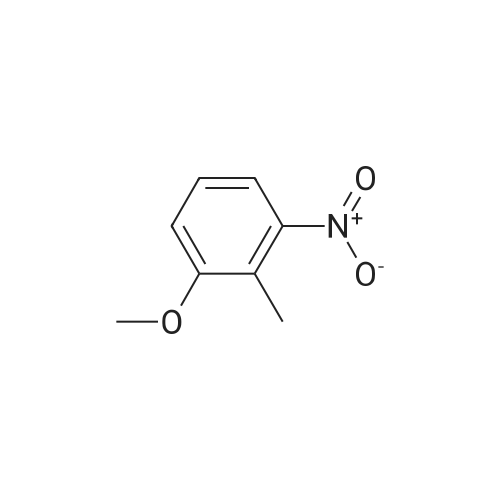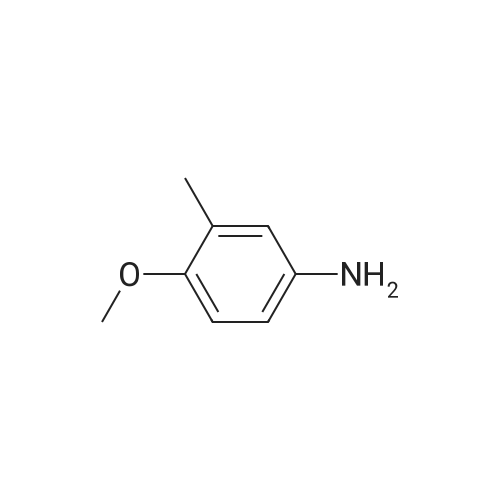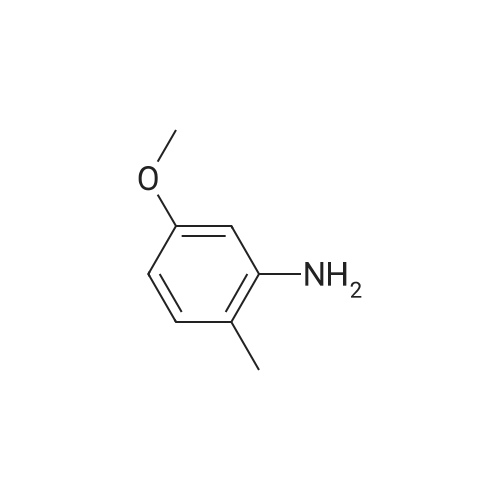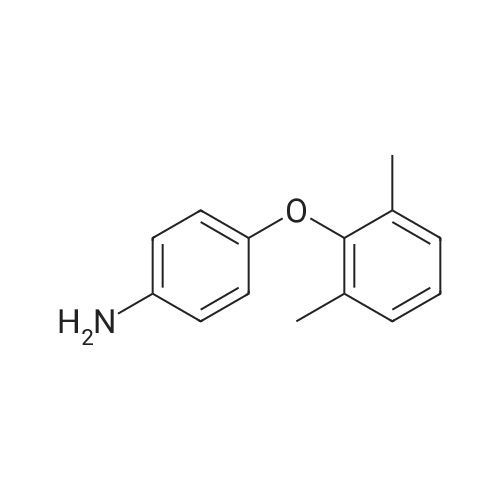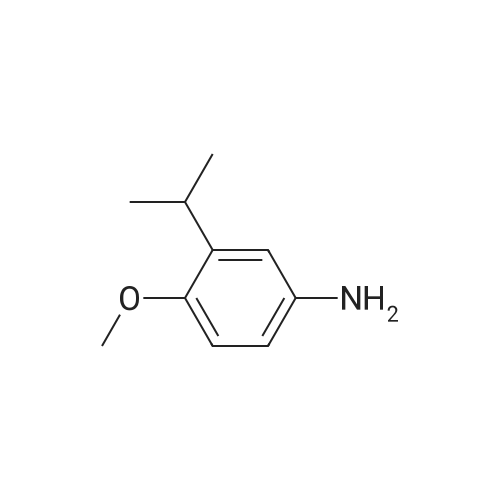| 98% |
With hydrogen;palladium 10% on activated carbon; In ethanol; at 20℃; for 19.0h; |
EXAMPLE 1A- SYNTHESIS OF P2 BUILDING BLOCK 2-METHYL-3-METHOXY ANILINE (1A2); EtOHPd/C(10%)H21a1 1a2To a solution of 2-methyl-3-nitro anisole which is commercially available (1a1) (5.1 g;30.33 mmol; requires -30 min. to dissolve) in absolute ethanol (85 ml_) was added10% Pd/C catalyst (500 mg). The solution was hydrogenated under a hydrogen filledballoon at atmospheric pressure and room temperature for 19 h. The reaction mixturewas filtered through a Celite pad, rinsed and evaporated to dryness to obtain thecompound 1a2 as a deep mauve oil (4.1 g; 29.81 mmol; 98% yield). MS 137 (MH)+.Reverse Phase HPLC Homogeneity (at) 220nm (0.06 % TFA;CH3CN;H2O): 99%. |
| 98% |
With hydrogen;palladium 10% on activated carbon; In ethanol; at 20℃; under 760.051 Torr; for 19.0h; |
To a solution of 2-methyl-3-nitro anisole which is commercially available (1a1) (5.1 g; 30.33 mmol; requires ~30 min. to dissolve) in absolute ethanol (85 mL) was added 10% Pd/C catalyst (500 mg). The solution was hydrogenated under a hydrogen filled balloon at atmospheric pressure and room temperature for 19 h. The reaction mixture was filtered through a Celite pad, rinsed and evaporated to dryness to obtain the compound 1a2 as a deep mauve oil (4.1 g; 29.81 mmol; 98% yield). MS 137 (MH)+. Reverse Phase HPLC Homogeneitya220nm (0.06% TFA;CH3CN;H2O): 99%. |
| 98% |
With hydrogen;palladium 10% on activated carbon; In ethanol; at 20℃; for 19.0h; |
To a solution of 2-methyl-3-nitro anisole which is commercially available (2a1) (5.1g ;30.33mmol ; requires ~30min. to dissolve) in absolute ethanol (85mL) was added 10%Pd/C catalyst (500mg) . The solution was hydrogenated under a hydrogen filledballoon at atmospheric pressure and room temperature for 19 hrs. The reactionmixture was filtered through a Celite pad, rinsed and evaporated to dryness to obtainthe compound 2a2 as a deep mauve oil (4.1g ; 29.81mmol ; 98 % yield). MS 137(MH)+. Reverse Phase HPLC Homogeneity (at) 220nm (0.06 % TFA;CH3CN;H20):99%. |
| 98% |
With hydrogen;palladium 10% on activated carbon; In ethanol; at 18 - 22℃; under 760.051 Torr; for 19.0h; |
EXAMPLE 2A; Synthesis of 1-methyl-2-methoxy aniline (2A2); To a solution of 2-methyl-3-nitro anisole (2A1) (5.1 g ; 30.33 mmol ; requires ~30min. to dissolve) in absolute ethanol (85 mL) was added 10% Pd/C catalyst (500 mg) . The solution was hydrogenated under a hydrogen filled balloon at atmospheric pressure and room temperature for 19 h. The reaction mixture was filtered through a Celite pad, rinsed and evaporated to dryness to obtain the compound 2A2 as a deep mauve oil (4.1 g ; 29.81 mmol ; 98% yield).MS 137 (MH)+. Reverse Phase HPLC Homogeneity (at) 220nm (0.06 % TFA ; CH3CN : H2O) : 99%. |
| 96% |
With formic acid; hydrazine; zinc; In methanol; at 5 - 61℃; for 2.0h; |
EXAMPLE 4: SYNTHESIS OF ILY-4001 [2-(3-(2-AMINO^-OXOACETYL)-I-(BIPHENYL-2-YLMETHYL)-2-METHYL-1H-INDOL-4-YLOXY)ACETIC ACID] (ME INDOXAM). [020112-Methyl-3-methoxyaniline (2) [04-035-11]. To a stirred cooled (ca. 50C) hydrazine hydrate (159.7 g, 3.19 mol), 85% formic acid (172.8 g, 3.19 mol) was added drop wise at 10 - 2O0C. The resultant mixture was added drop wise to a stirred suspension of zinc dust (104.3 g, 1.595 mol) in a solution of 2-methyl-3-nitroanisole (1) (53.34 g, 0.319 mol) in methanol (1000 mL). An exothermic reaction occurred. After the addition was complete, the reaction mixture was stirred for additional 2 h (until temperature dropped from 61 C to RT) and the precipitate was filtered off and washed with methanol (3x150 mL). The filtrate was concentrated under reduced pressure to a volume of ca. 250 mL. The residue was treated with EtOAc (500 ml) and saturated aqueous NaHCO3 (500 mL). The aqueous phase was separated off and discarded. The organic phase was washed with water (300 mL) and extracted with 1 N HCI (800 mL). The acidic extract was washed with EtOAc (300 mL) and was basisified with K2CO3 (90 g). The free base 2 was extracted with EtOAc (3x200 mL) and the combined extracts were dried over MgSO4. After filtration and removal of the solvent from the filtrate, product 2 was obtained as a red oil, which was used in the next step without further purification. Yield: 42.0 g (96%). |
| 96% |
With formic acid; hydrazine; zinc; In methanol; at 20 - 61℃; for 2.0h; |
2-Methyl-3-methoxyaniline (2); [04-035-11]. To a stirred cooled (ca. 5C) hydrazine hydrate (159.7 g, 3.19 mol), 85% formic acid (172.8 g, 3.19 mol) was added drop wise at 10 - 2O0C. The resultant mixture was added drop wise to a stirred suspension of zinc dust (104.3 g, 1.595 mol) in a solution of 2-methyl-3-nitroanisole (1) (53.34 g, 0.319 mol) in methanol (1000 mL). An exothermic reaction occurred. After the addition was complete, the reaction mixture was stirred for additional 2 h (until temperature dropped from 61 C to RT) and the precipitate was filtered off and washed with methanol (3x150 mL). The filtrate was concentrated under reduced pressure to a volume of ca. 250 mL. The residue was treated with EtOAc (500 ml) and saturated aqueous NaHCO3 (500 mL). The aqueous phase was separated off and discarded. The organic phase was washed with water (300 mL) and extracted with 1 N HCI (800 mL). The acidic extract was washed with EtOAc (300 mL) and was basisified with K2CO3 (90 g). The free base 2 was extracted with EtOAc (3x200 mL) and the combined extracts were dried over MgSO4. After filtration and removal of the solvent from the filtrate, product 2 was obtained as a red oil, which was used in the next step without further purification. Yield: 42.0 g (96%). |
| 96% |
|
[00305] 2-Methyl-3-methoxyaniline (2) [04-035-11]. To a stirred cooled (ca. 5C) hydrazine hydrate (159.7 g, 3.19 mol), 85% formic acid (172.8 g, 3.19 mol) was added drop wise at 10 - 200C. The resultant mixture was added drop wise to a stirred suspension of zinc dust (104.3 g, 1.595 mol) in a solution of 2-methyl-3-nitroanisole (1) (53.34 g, 0.319 mol) in methanol (1000 mL). An exothermic reaction occurred. After the addition was complete, the reaction mixture was stirred for additional 2 h (until temperature dropped from 61 C to RT) and the precipitate was filtered off and washed with methanol (3x150 mL). The filtrate was concentrated under reduced pressure to a volume of ca. 250 mL. The residue was treated with EtOAc (500 ml) and saturated aqueous NaHCO3 (500 mL). The aqueous phase was separated off and discarded. The organic phase was washed with water (300 mL) and extracted with 1 N HCI (800 mL). The acidic extract was washed with EtOAc (300 mL) and was basisified with K2CO3 (90 g). The free base 2 was extracted with EtOAc (3x200 mL) and the combined extracts were dried over IVIgSO4. After filtration and removal of the solvent from the filtrate, product 2 was obtained as a red oil, which was used in the next step without further purification. Yield: 42.0 g (96%). |
| 96% |
With formic acid; hydrazine; zinc; In methanol; at 61℃; for 2.0h; |
2-Methyl-3-methoxyaniline (2) [04-035-11]. ; To a stirred cooled (ca. 5C) hydrazine hydrate (159.7 g, 3.19 mol), 85% formic acid (172.8 g, 3.19 mol) was added drop wise at 10 - 20C. The resultant mixture was added drop wise to a stirred suspension of zinc dust (104.3 g, 1.595 mol) in a solution of 2-methyl-3-nitroanisole (1) (53.34 g, 0.319 mol) in methanol (1000 mL). An exothermic reaction occurred. After the addition was complete, the reaction mixture was stirred for additional 2 h (until temperature dropped from 61 C to RT) and the precipitate was filtered off and washed with methanol (3x150 mL). The filtrate was concentrated under reduced pressure to a volume of ca. 250 mL. The residue was treated with EtOAc (500 ml) and saturated aqueous NaHCO3 (500 mL). The aqueous phase was separated off and discarded. The organic phase was washed with water (300 mL) and extracted with 1N HCI (800 mL). The acidic extract was washed with EtOAc (300 mL) and was basisified with K2CO3 (90 g). The free base 2 was extracted with EtOAc (3x200 mL) and the combined extracts were dried over MgSO^ After filtration and removal of the solvent from the filtrate, product 2 was obtained as a red oil, which was used in the next step without further purification. Yield: 42.0 g (96%). |
| 96% |
|
To a stirred cooled (ca. 5 C.) hydrazine hydrate (159.7 g, 3.19 mol), 85% formic acid (172.8 g, 3.19 mol) was added drop wise at 10-20 C. The resultant mixture was added drop wise to a stirred suspension of zinc dust (104.3 g, 1.595 mol) in a solution of 2-methyl-3-nitroanisole (1) (53.34 g, 0.319 mol) in methanol (1000 mL). An exothermic reaction occurred. After the addition was complete, the reaction mixture was stirred for additional 2 h (until temperature dropped from 61 C. to RT) and the precipitate was filtered off and washed with methanol (3×150 mL). The filtrate was concentrated under reduced pressure to a volume of ca. 250 mL. The residue was treated with EtOAc (500 ml) and saturated aqueous NaHCO3 (500 mL). The aqueous phase was separated off and discarded. The organic phase was washed with water (300 mL) and extracted with 1N HCl (800 mL). The acidic extract was washed with EtOAc (300 mL) and was basisified with K2CO3 (90 g). The free base 2 was extracted with EtOAc (3×200 mL) and the combined extracts were dried over MgSO4. After filtration and removal of the solvent from the filtrate, product 2 was obtained as a red oil, which was used in the next step without further purification. Yield: 42.0 g (96%). |
|
In aluminum nickel; ethanol; |
3-Methoxy-2-methyl-aniline 200 gm (1.19 mols) of 2-methoxy-6-nitro-toluene were hydrogenated in 2.5 liters of ethanol in the presence of 25 gm of Raney nickel at 100 bar until the absorption of the calculated amount of hydrogen. The reaction mixture was filtered and evaporated in vacuo. After distillation 158.3 gm (97% of theory) of 3-methoxy-2-methylaniline were obtained. B.p.: 126 C. at 16.25 mbar. |
|
With hydrogen;5%-palladium/activated carbon; In methanol; at 20℃; |
2-Methoxy-6-aminotoluene; 2-methyl-3-nitroanisole (20 g, 0.12 mol) was suspended in methanol (200 ml) at RT under nitrogen. Pd/C (5%, 2 g) was added and the system was shaken under an atmosphere of hydrogen overnight, until TLC indicated one product. The reaction mixture was filtered through celite, and the celite washed with methanol (3 x 100 ml) and the filtrate concentrated in vacuo. This afforded 18 g of a red oil that was used without further purification. No.H (CDCl3; 250MHz) 7.01 (1 H, t, J 8, aromatics), 6.38 (2H, d, J 8, aromatics), 3.83 (3H, s, OCH3), 2.08 (3H, s, CH3). |
|
With hydrogen;palladium 10% on activated carbon; In ethanol; for 6.0h; |
A mixture of 2-methyl-3-nitroanisole (16.7 g), 10 % Pd-C (1.6 g) and ethanol (330 ml) was stirred in hydrogen atmosphere for 6 hours. The insoluble residue was filtrated and the filtrate was concentrated under reduced pressure to give a title compound (12.5 g). NMR (CDCl3): delta 2.04(3H,s), 3.71(3H,s), 6.33-6.36(2H,m), 6.94-7.00(1H,m). |
|
With hydrogen;5% palladium over charcoal; In ethanol; at 20℃; for 3.0h; |
(Reference Example 27) Synthesis of 3-amino-2-methylanisole (Reference compound 27) A suspension of 9.98 g of 5% palladium-carbon (hydrous) in 100 ml of ethanol was added to a solution of 30.7 g (184 mmol) of 2-methyl-3-nitroanisole in 300 ml of ethanol and the mixture was stirred for 3 hours at room temperature in a hydrogen atmosphere. After the reaction was completed, the reaction solution was filtered through Celite and the filtrate was concentrated under reduced pressure, whereby 25.5 g of the title compound was obtained as a slightly purple oily substance (yield: quantitative). Rf value: 0.38 (n-hexane: ethyl acetate = 2: 1 (v/v)) Mass spectrum (EI, m/z): 137 (M+) 1H-NMR spectrum (CDCl3, deltappm): 2.04-2.05 (m, 3H), 3.60 (brs, 2H), 3.80 (s, 3H), 6.33-6.37 (m, 2H), 6.94-7.01 (m, 1H) |
|
With hydrogen;palladium 10% on activated carbon; for 1.0h; |
Intermediate 58methyloxy)anilineTo a solution of 2-methyl-1 -(methyloxy)-3-nitrobenzene (Intermediate 57, 1.67 g) in methanol (50 mL) was added Pd/C (10%, 50 mg) and the reaction mixture was stirred under H2 atmosphere for 1 hour. The mixture was filtered through a pad of celite. Evaporation afforded the title compound as a solid (1.31 g). |
| 8.59 g |
With palladium 10% on activated carbon; hydrogen; In ethyl acetate; at 20℃; for 6.0h; |
Methyl iodide (8.13 mL, 130.6 mmol) was added dropwise to a solution of 8 (10 g, 65.29 mmol) ,and potassium carbonate (18.05 g, 130.6 mmol) in anhydrous DMF (130 mL). The reaction mixture was stirred at rt for 14 h and quenched by the addition of H2O (250 mL). The aqueous phase was extracted with EtOAc (3 × 200 mL), the combined organic layers washed with water (100 mL), saturated sodium chloride solution, dried over anhydrous sodium sulfate, filtered, and concentrated to give corresponding methyl ether as a colorless solid. Palladium on carbon (10%, 200 mg) was added to a solution of above product in EtOAc (130 mL). The suspension was stirred at rt for 6 h under a hydrogen atmosphere before it was filtered through a plug of celite and eluted with EtOAc (150 mL). The eluent was concentrated to afford 12 (8.59 g, 96% over two steps) as a colorless amorphous solid: 1H NMR (500 MHz, CDCl3) delta 6.97 - 6.83 (m, 1H), 6.37 - 6.20 (m, 2H), 3.72 (s, 3H), 3.54 (br s, 2H), 1.97 (s, 3H); 13C NMR (125 MHz, CDCl3) delta 158.2, 145.6, 126.5, 110.4, 108.4, 101.2, 55.6, 8.9. |

 Chemistry
Chemistry
 Pharmaceutical Intermediates
Pharmaceutical Intermediates
 Inhibitors/Agonists
Inhibitors/Agonists
 Material Science
Material Science













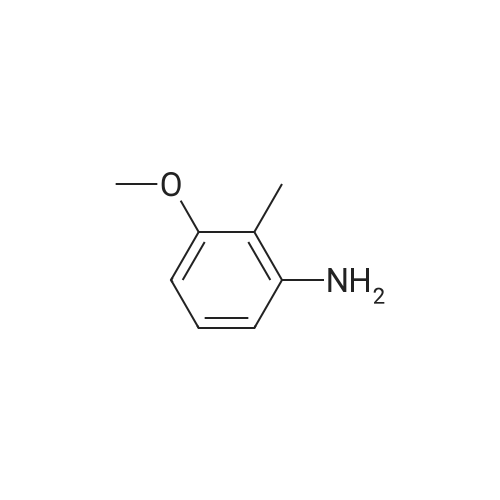

 For Research Only
For Research Only
 120K+ Compounds
120K+ Compounds
 Competitive Price
Competitive Price
 1-2 Day Shipping
1-2 Day Shipping




